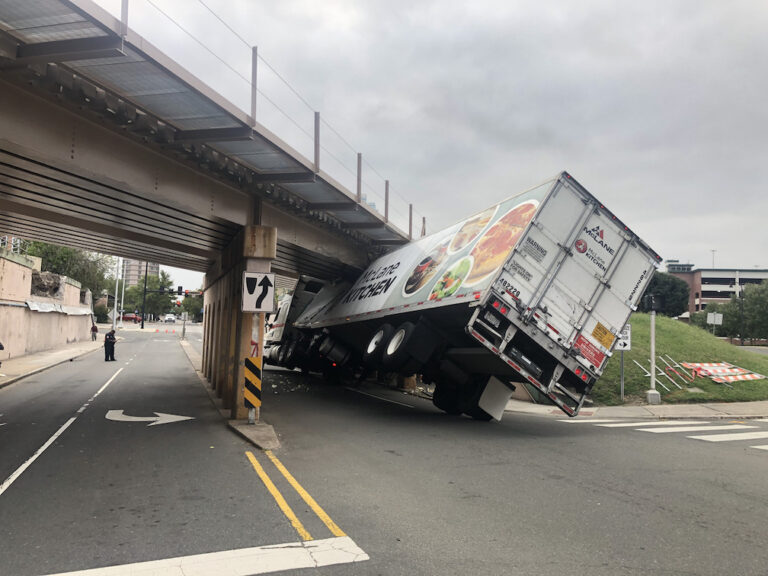WASHINGTON — One roadway traffic issue that has recently caused concern — a rash of bridge strikes by motor vehicles — was addressed during a “Talking Freight” webinar hosted by the U.S. Department of Transportation.
Jeff Purdy, the freight programs team leader in the Federal Highway Administration’s Office of Freight Management and Operations, says his team has been working on a study to help prevent and mitigate the risk of bridge and tunnel strikes by motor vehicles. The National Cooperative Highway Research Program (NCHRP) study is being conducted in cooperation with the American Association of State Highway and Transportation Officials (AASHTO) and state departments of transportation through the Transportation Research Board.
Purdy cited numerous possible causes, including improperly loaded trucks or equipment malfunctions.
“(We’re) looking at some of these causation factors, whether it’s an infrastructure issue or a driver issue or a GPS routing issue,” he said. “What we’re trying to do is develop a comprehensive set of solutions to to try to address the issues.”
Some of those issues include inadequate vertical clearance, changes in transition zones, inadequate signage both at and on the approach of low bridges, lack of provisions for alternative routes around low bridges, drivers’ lack of knowledge of their vehicle and cargo heights, or improperly loaded equipment and load shifts.
Purdy also stated that no U.S. states provide lane-by-lane vertical clearance signing, citing an investigation by the National Transportation Safety Board (NTSB). The incident in question, which occured in 2013, involved the Skagit River Bridge on Interstate 5 in Washington State: A truck hauling an oversized load struck the bridge’s overhead truss causing the bridge span to collapse. The truck, was led by a pilot vehicle and had the proper permits for the route — but the truck did not travel in the proper lane with to gain adequate clearance.
The NTSB found that contributing factors to the accident included insufficient route planning and failure on the part of the pilot vehicle to properly perform its duties, in part because the driver of the pilot car was distracted by cellphone usage, in addition to inadequate evaluation of oversized load permit requests and a lack of provision for low clearance warning signs in advance of the bridge
NTSB provided a series of recommendations to develop a best-practices guide for preventing bridge strikes.
Purdy says this will require “looking at a framework for collecting bridge strike data and communicating between agencies responsible for bridge inspections and agencies responsible for issuing oversize and overweight loads, practices for using data to develop operational changes, methods for evaluating bridge strike countermeasures, and then review of countermeasures that are proved effective in terms of preventing bridge strikes by vehicles, both domestic countermeasures as well as countermeasures being used in in other countries.”
The NTSB investigation also provided more policies and practices. One isan update to the Manual on Uniform Traffic Control Devices (MUTCD) with regard to signage for low clearance structures, as well as an update to the pilot car and escort vehicle best practice guidelines.
Purdy said the work with other agencies on its study came up with objectives, including developing what he called a “prototype national data clearinghouse” that would allow for collection and analysis of bridge strike data while developing a roadmap on how to update and maintain the data set using this data set developing a risk-based, data-driven approach to evaluate the risk of bridge and tunnel strikes.
“By analyzing this data, we can start to see patterns,” Purdy said. “We can see correlations between infrastructure conditions, traffic conditions, situations surrounding the individual crash reports and start to develop methods for identifying the most appropriate countermeasures to apply along individual corridors or at individual structures.”
Another objective is to identify and lay out countermeasures for preventing bridge strikes that can be utilized as well as looking at the vehicle, permitting process for oversized and overweight loads, and developing a guide for state dots and other agencies enforcement agencies to be able to implement these recommendations, in addition to developing training and outreach material for the trucking industry and other agencies on ways of preventing bridge and tunnel strikes.
That guide is set to be released this winter.
Bruce Guthrie is an award-winning journalist who has lived in three states including Arkansas, Missouri and Georgia. During his nearly 20-year career, Bruce has served as managing editor and sports editor for numerous publications. He and his wife, Dana, who is also a journalist, are based in Carrollton, Georgia.














we see it all the time. Matt Hazel actually came up with solutions for the car transport industry. but has never been taken up on his solution’s.
I’ve been a driver using all sorts of different GPS’s to get from point a to point be and none of them are the same. I really don’t understand why truck drivers can’t have a competent GPS app? The ELD’s in their trucks hold GPS coordinates, don’t they? I’m not math genius or computer guru but couldn’t we come up with some sort of algorithm to program these GPS’s? These trucks have been to every loading dock imaginable. Isn’t that data on the ELD’s? If this is a great idea, don’t exclude me.